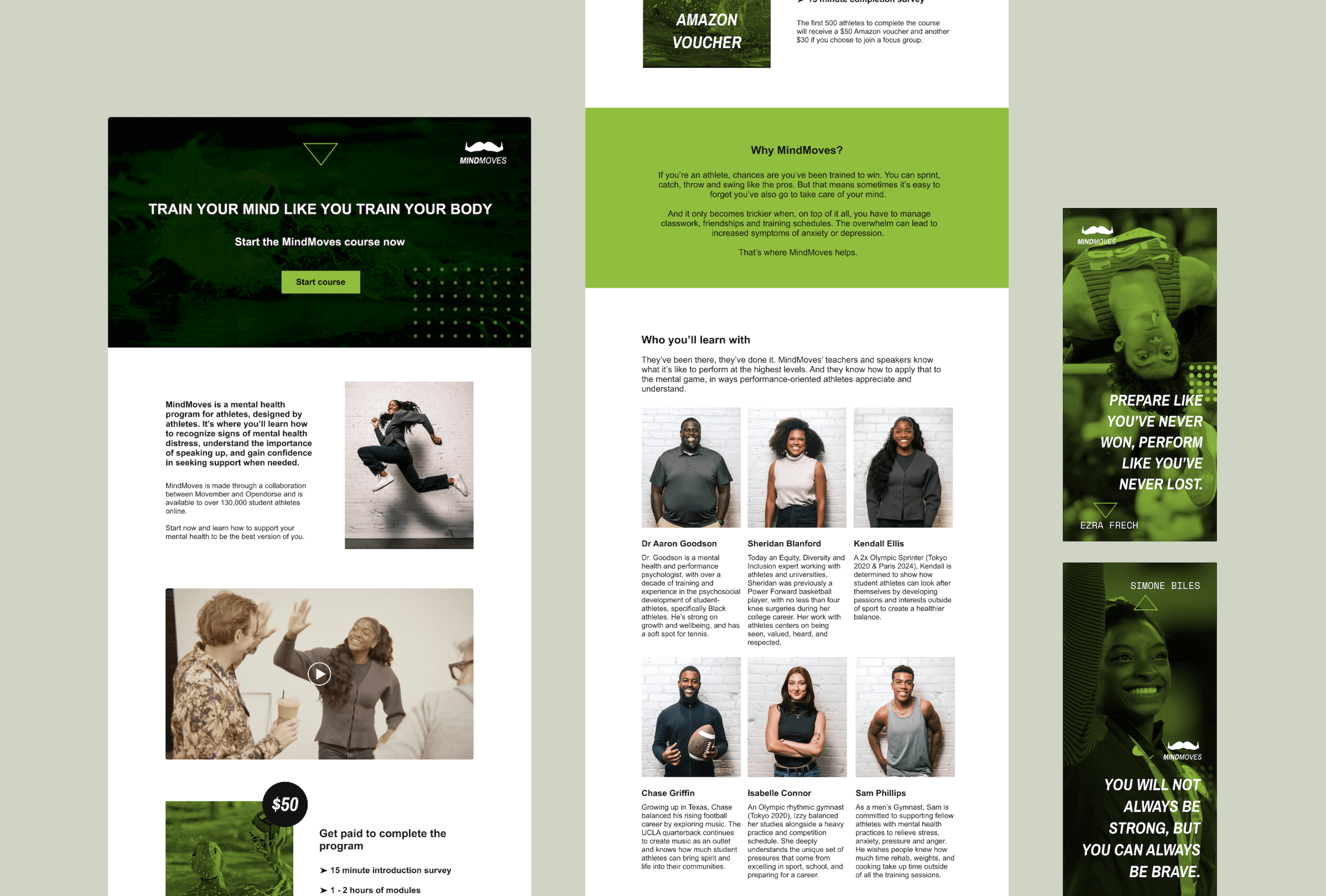Content learning design case study
Movember was developing an evidence-based program to support college athletes with their mental health, so we jumped onboard to pull it together.

In partnership with Opendorse (a platform for athletes), MindMoves was being launched across the USA. The internal goals were set, Movember had surveyed hundreds of student athletes, and the researchers had run a number of focus groups, so the program was ready to be created. The US Movember division was wonderful and I got to work alongside an awesome Orbit29 Product Manager and Product Director, allowing me to focus on the learning outcomes.
2024 Project
The scope
Worked on this project with Orbit29 to lead the learning content design to develop, refine and release an evidence-based athletic mental health program.
My role
Content learning designer working alongside a wonderful Orbit product manager, and the Movember team who made it all happen.
Audience
NCAA college athletes across the USA, generally in the 17 - 24 age bracket. Though the content could be consumed by all, the focus was for men.
Credits
Big thank you to Sheridan Blanford and Dr. Aaron Goodson for their expertise, Chase Griffin, Isabelle Connor, Samuel Phillips, Kendall Ellis, and DJ Justice for their athlete insights, Unfeatured Films for video production, and of course the Mo team!
Understanding the athlete mental health space
To quickly map my way across the existing work, I reviewed the in-progress Theory of Change and academic literature. Not knowing how much formally existed for athletes in this space these days, I also conducted a quick exploration of the primary services. Lastly, having been a former athlete and staying fairly abreast of issues affecting numerous sports, I pulled up recent articles, video interviews, social posts, and books from athletes that spoke to their experiences in relation to mental health.
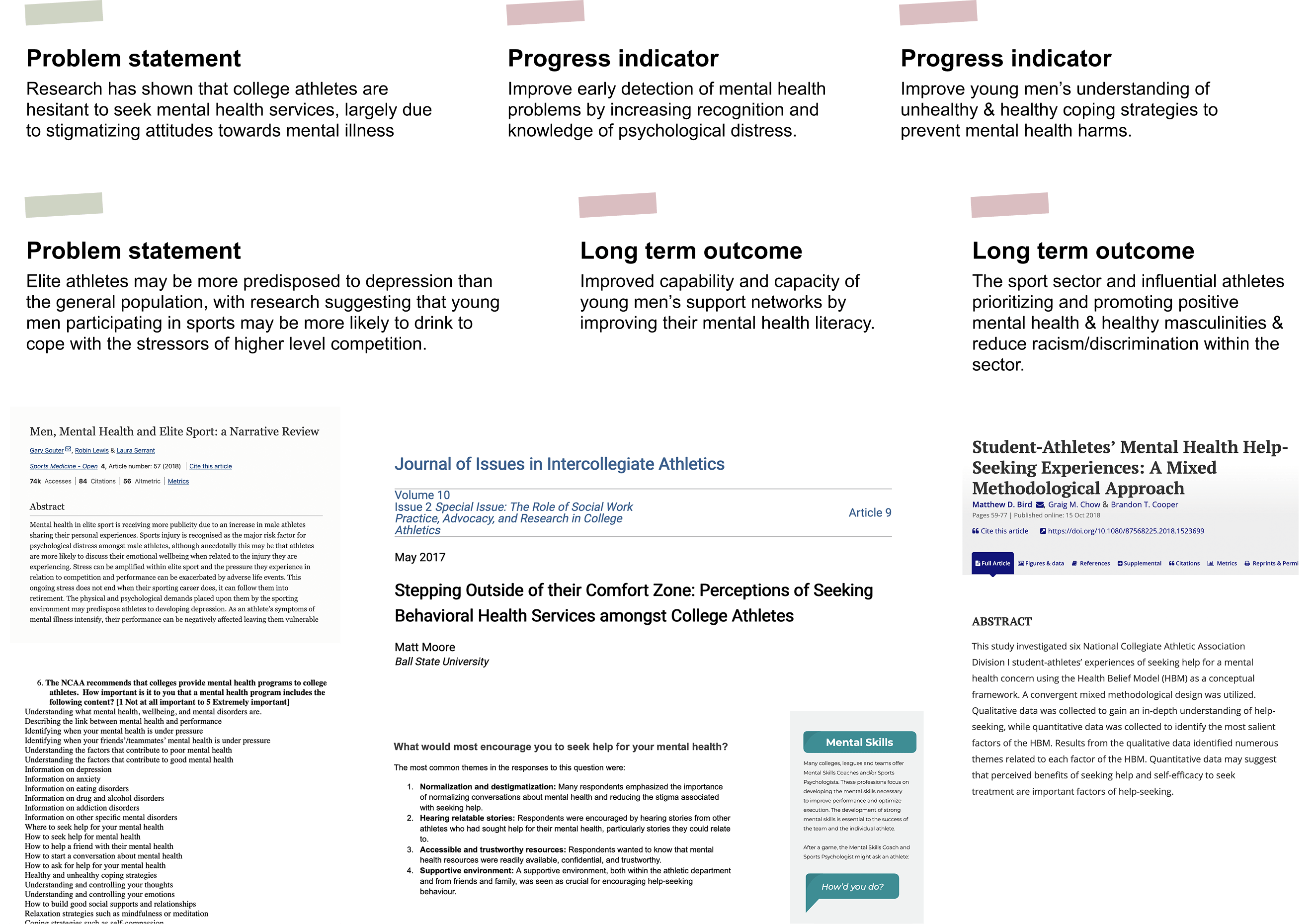
The product manager had pulled together the high-level athlete needs into stories. To structure our direction, I grouped these and then expanded on the needs scenarios so we had tangible and relatable stories that we could create learning modules for.
Establishing athlete needs and Movember goals

Developing the modules with the academics
With the base set, I grouped learning outcomes into modules and developed a structure for these so we could review them together. I needed to ensure that we retained practical usefulness for athletes, rather than being another broad mental health module, while also balancing Movember's needs of starting broader before creating specifics in future rollouts. I guided activity development, and outlined the content inclusions that would best meet the learning outcomes within the requirements, so we could visualize what would need to be developed. There had also understandably been more context provided for team sports, whereas solo sports also see large athlete participation, and while there is significant overlap, both have some different challenges to be addressed. Lastly, recognizing the diversity of the athlete group across all sports and the presence of multiple systemic issues, we advocated for a deeply inclusive approach. The team embraced this direction, and we were careful to avoid reinforcing stereotypes associated with hegemonic masculinity.
Thought experiment: How are the men in diving and gymnastics viewed vs football? What pressures exist in one that don't exist in the other? What is considered acceptable in one but not the other? How might a man's behavior need to change in one or the other?


Creating an outline of the course
Once we agreed to the full content framework and content development required, the academic team began working on this. The Opendorse platform runs on Teachable for the LMS. Teachable doesn't allow much customization of content outside custom coding (which requires a team to maintain), so we needed to structure everything with the standard modules provided. I took our framework, whipped up a quick component library, and wireframed each submodule so we could review the user journey, change layouts, and visualize it as the content came together.

Storyboarding the videos and creating video scripts
Since videos were a core component of the content we needed to produce, I developed a basic storyboard for each and created an interview brief to help guide the conversation naturally, ensuring we captured the key material needed for the final edits. In this way we could also start to really understand how the learning would largely take place.
Try for yourself: I often tried to use scenarios that would encourage an expert to think of ways to explain a content learning outcome in an athlete-relatable scenario. "Are you hurting, or are you injured?" came up during one of our calls as a reflection of this. Experts already know what they're talking about so it's more ensuring interview briefs match the modules you're looking to create and ensure their expertise on it is raised.
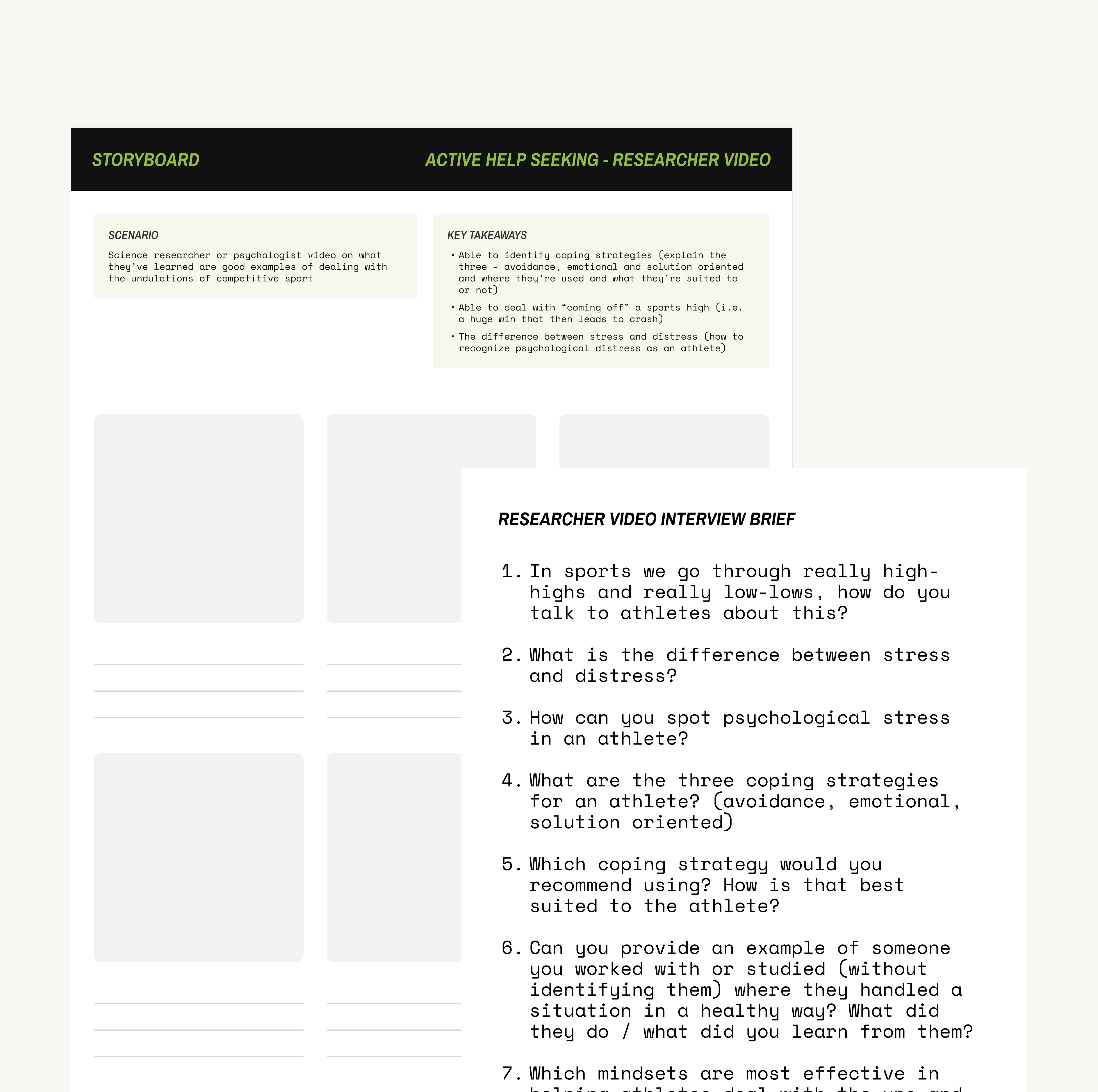
Detailed review of interview guidance
The interview briefs went through numerous rounds of review so we could ensure we always lined up with academic expectations and bring everyone's expertise into the submodules. My role through this was to ensure we remained focused, weren't scripting for a specific scenario, were representative and inclusive, and addressed common and relatable problems with respect to the learning outcomes. Going through this process across our teams made our final content significantly better, and I am really grateful we had the opportunity to do this.
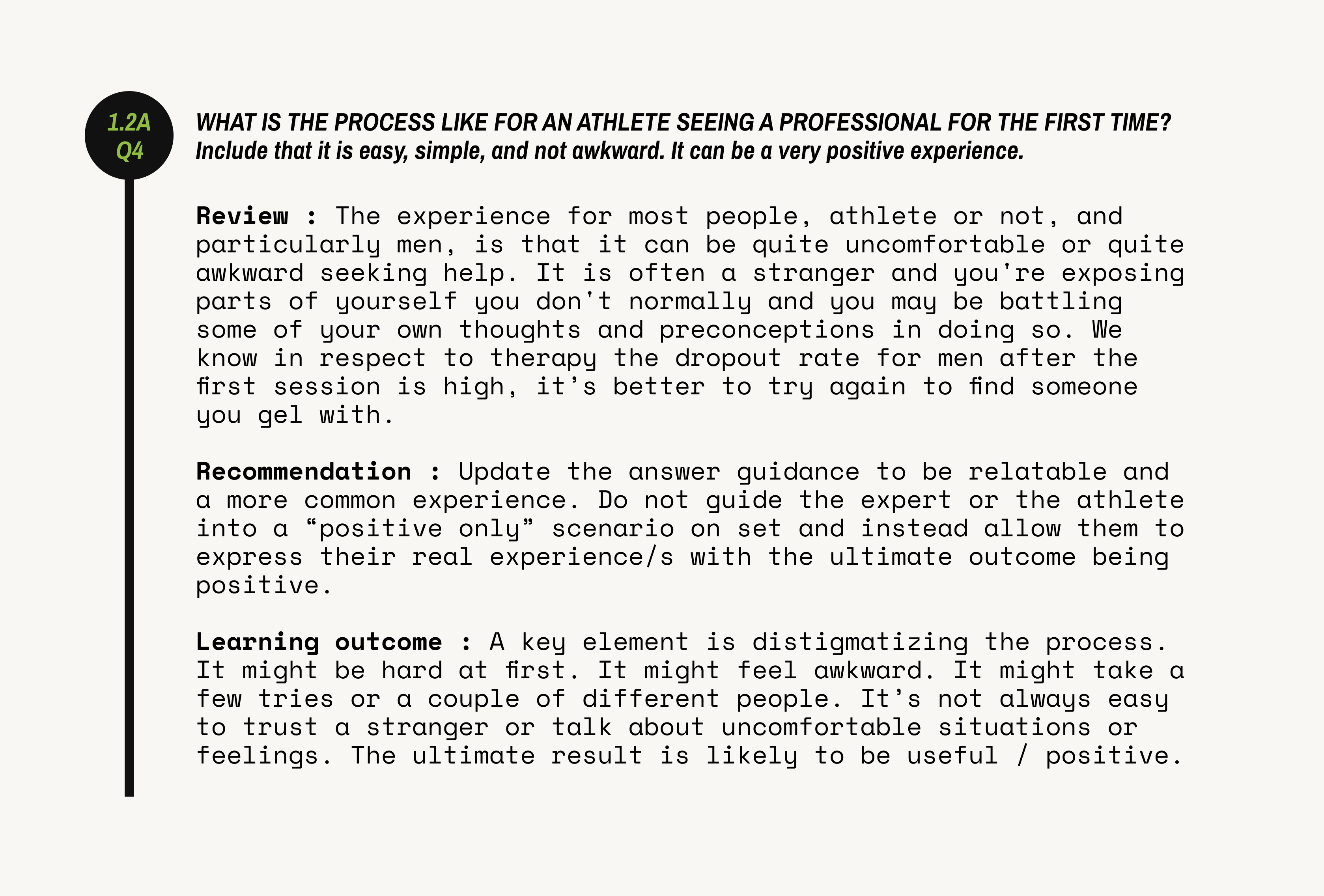

Designing the activities and modules
As we were working with the academics on crafting the activities and these were starting to come together, I designed out each wireframe into the final edition of the submodules. We had chosen to keep written content limited as this is a younger group, extremely busy, and used to consuming content in short-form videos. We did, however, want to provide useful and practical activities and techniques that could be implemented by athletes that genuinely support their mental health and ultimately their performance. Our expert in structural issues had also created some excellent reflections we wanted to make sure were available, as even reading a one-line question can trigger awareness of a challenge someone might be experiencing.

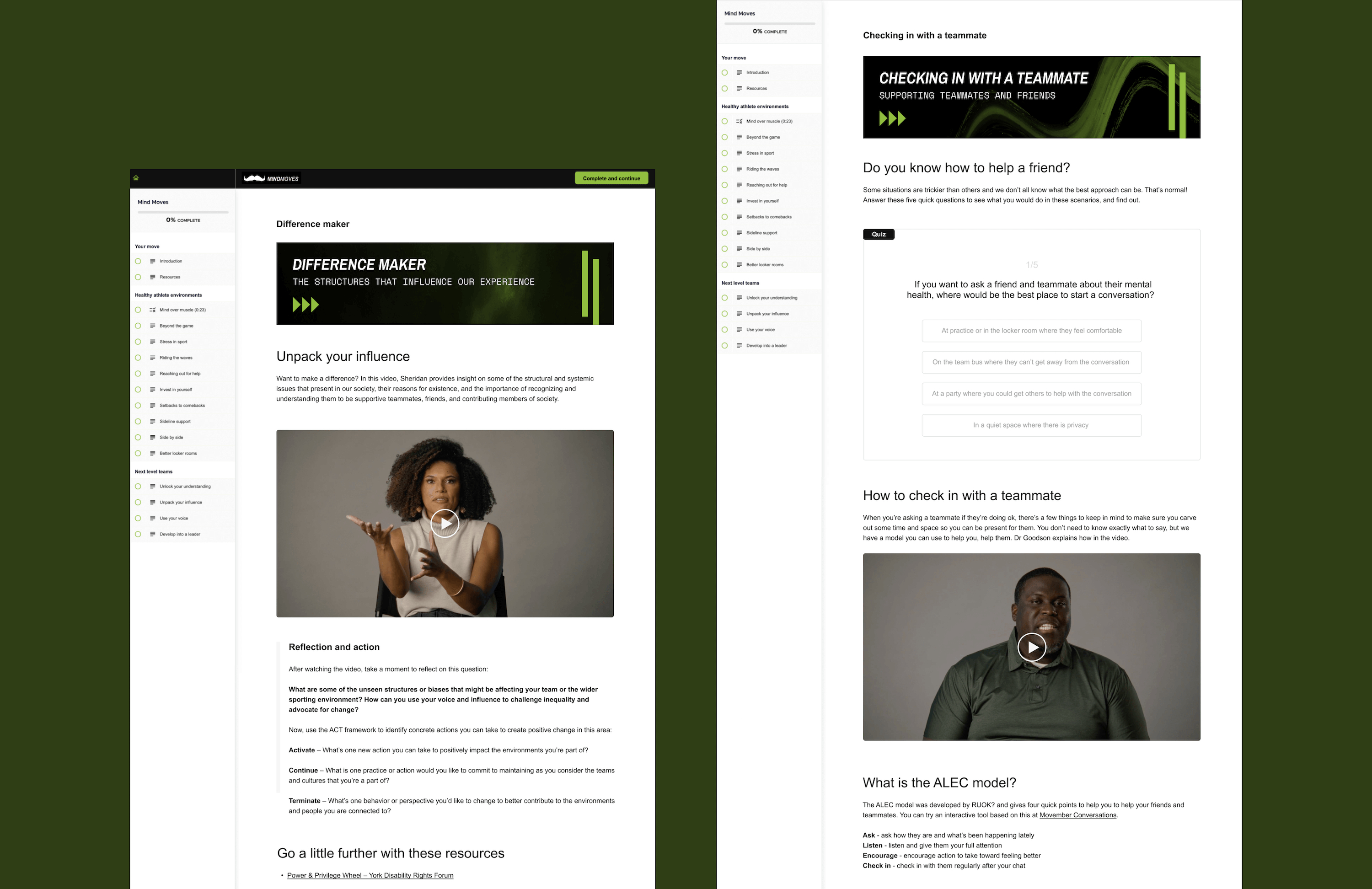
Reviewing the videos for cuts and chop ups
I spent time with the product manager reviewing the edits of the video so we could make sure the final cuts aligned with the learning outcomes and suggest bits and pieces to pull in and out from the footage for the final versions. This work is quite laborious (I imagine at hundredfold for films, series, and documentaries!) but makes the final clips feel natural and polished. Through this process, we could also visualize how the videos might be chopped up for different social channels in the future where a lot of athletes are natively talking about their experiences.
Launching and RCT preparation
The final 10% of a project often feels like a whole lot more! In this case we were testing, advising on launch, preparing for the RCT (randomized controlled trial) , and I was designing out a landing page and writing up a bunch of final pages so the flows of the pre-during-post RCT would work. The Movember team was brilliant during this process and we made it to the launch date to see the athlete signups start rushing in. I began work on the next component of this project which has more specific knowledge and techniques for athlete performance - excited to see how this grows!
